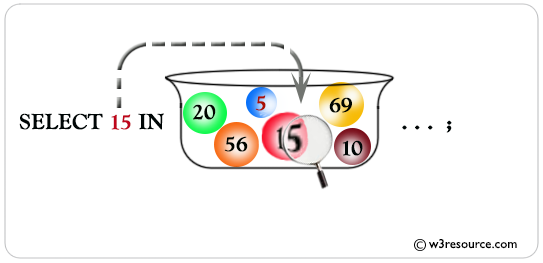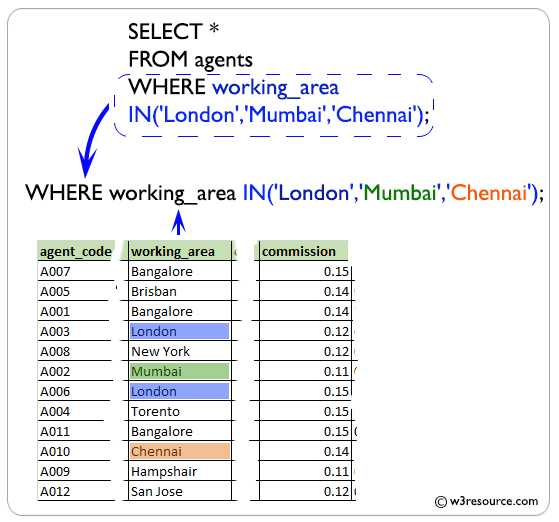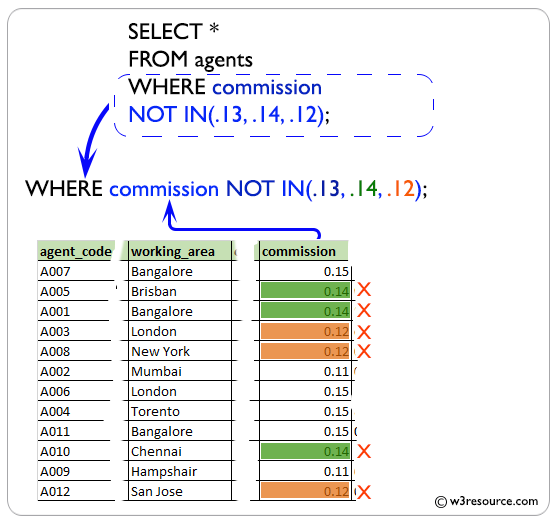SQL IN Operator
IN operator
The IN operator checks a value within a set of values separated by commas and retrieve the rows from the table which are matching. The IN returns 1 when the search value present within the range otherwise returns 0.
Syntax:
SELECT [column_name... | expression ]
FROM [table_name]
{WHERE | HAVING | {AND | OR}} value [NOT] IN ({comp_value1, comp_value2[, ...] | subquery});
Parameters:
| Name | Description |
|---|---|
| column_name | Name of the column of the table. |
| expression | Expression made up of a single constant, variable, scalar function, or column name and can also be the pieces of a SQL query that compare values against other values or perform arithmetic calculations. |
| table_name | Name of the table |
| {WHERE | HAVING | {AND | OR}} value | IN works with either the WHERE or the HAVING clause. You can also use AND or OR clause for multi-condition WHERE or the HAVING clause. |
| NOT | Used to exclude the defined multiple values in a WHERE clause condition. |
| comp_value1, comp_value2...| subquery | List of comparative values within the parentheses or a subquery that returns one or more values of a compatible datatype of the main query. |
DBMS Support:IN Operator
| DBMS | Command |
| MySQL | Supported |
| PostgreSQL | Supported |
| SQL Server | Supported |
| Oracle | Supported |
Example: SQL IN Operator
To know whether the search value 15 is present within the specified range from the DUAL table, the following SQL statement can be used :
SQL Code:
SELECT 15 IN (5,10,15,20,56,69)
FROM dual;Pictorial Presentation :

SQL IN operator with text value
The checking value of IN operator can be a string or word or sentence. These values can also be checked within a set of values separated by commas and retrieve the rows containing these values.
Example:
Sample table: agents
Here we look for all agents in the agents table of inventory database who have a working area of the state of 'London', 'Mumbai' or 'Chennai'.
Here is the SQL statement:
SQL Code:
SELECT *
FROM agents
WHERE working_area IN('London','Mumbai','Chennai');
This statement can also be used like bellow:
SQL Code:
SELECT *
FROM agents
WHERE working_area='London' OR working_area='Mumbai' OR working_area='Chennai';
Output:
AGENT_CODE AGENT_NAME WORKING_AREA COMMISSION PHONE_NO COUNTRY ---------- -------------------- -------------------- ---------- --------------- ---------- A003 Alex London .13 075-12458969 A010 Santakumar Chennai .14 007-22388644 A002 Mukesh Mumbai .11 029-12358964 A006 McDen London .15 078-22255588
Relational Algebra Expression:

Relational Algebra Tree:

Relational Algebra Expression:

Relational Algebra Tree:

Pictorial Presentation : SQL IN operator with text value

SQL IN operator with numeric value
How can a numeric value be searched within a list of supplying values using IN operator in a select statement?
Example:
Sample table: agents
To get data of all columns from the 'agents' table with the following condition -
1.'commission' for the agents will be any of .13, .14 and .12,
the following SQL statement can be used :
SQL Code:
SELECT *
FROM agents
WHERE commission IN (.13,.14,.12);
Output:
AGENT_CODE AGENT_NAME WORKING_AREA COMMISSION PHONE_NO COUNTRY ---------- -------------------- -------------------- ---------- --------------- ------------ A003 Alex London .13 075-12458969 A001 Subbarao Bangalore .14 077-12346674 A008 Alford New York .12 044-25874365 A010 Santakumar Chennai .14 007-22388644 A012 Lucida San Jose .12 044-52981425 A005 Anderson Brisban .13 045-21447739
SQL IN operator with boolean NOT
In the following example, we have discussed the usage of IN operator with the boolean operator NOT in a select statement.
Example:
Sample table: agents
To get data of all columns from the 'agents' table with the following condition -
1. 'commission' for the agents will be none of .13, .14, .12,
the following SQL statement can be used:
SQL Code:
SELECT *
FROM agents
WHERE commission NOT IN (.13,.14,.12);
Output:
AGENT_CODE AGENT_NAME WORKING_AREA COMMISSION PHONE_NO COUNTRY ---------- -------------------- -------------------- ---------- --------------- --------- A009 Benjamin Hampshair .11 008-22536178 A007 Ramasundar Bangalore .15 077-25814763 A011 Ravi Kumar Bangalore .15 077-45625874 A002 Mukesh Mumbai .11 029-12358964 A006 McDen London .15 078-22255588 A004 Ivan Torento .15 008-22544166
Pictorial Presentation : SQL IN operator with boolean NOT

Practice SQL Exercises
- SQL Exercises, Practice, Solution
- SQL Retrieve data from tables [33 Exercises]
- SQL Boolean and Relational operators [12 Exercises]
- SQL Wildcard and Special operators [22 Exercises]
- SQL Aggregate Functions [25 Exercises]
- SQL Formatting query output [10 Exercises]
- SQL Quering on Multiple Tables [8 Exercises]
- FILTERING and SORTING on HR Database [38 Exercises]
- SQL JOINS
- SQL SUBQUERIES
- SQL Union[9 Exercises]
- SQL View[16 Exercises]
- SQL User Account Management [16 Exercise]
- Movie Database
- BASIC queries on movie Database [10 Exercises]
- SUBQUERIES on movie Database [16 Exercises]
- JOINS on movie Database [24 Exercises]
- Soccer Database
- Introduction
- BASIC queries on soccer Database [29 Exercises]
- SUBQUERIES on soccer Database [33 Exercises]
- Hospital Database
- Employee Database
- More to come!
Want to improve the above article? Contribute your Notes/Comments/Examples through Disqus.
SQL: Tips of the Day
SQL Server SELECT into existing table.
INSERT INTO dbo.TABLETWO SELECT col1, col2 FROM dbo.TABLEONE WHERE col3 LIKE @search_key
This assumes there's only two columns in dbo.TABLETWO - you need to specify the columns otherwise:
INSERT INTO dbo.TABLETWO (col1, col2) SELECT col1, col2 FROM dbo.TABLEONE WHERE col3 LIKE @search_key
Database: SQL Server
Ref: https://bit.ly/3y6tpA3
- New Content published on w3resource:
- HTML-CSS Practical: Exercises, Practice, Solution
- Java Regular Expression: Exercises, Practice, Solution
- Scala Programming Exercises, Practice, Solution
- Python Itertools exercises
- Python Numpy exercises
- Python GeoPy Package exercises
- Python Pandas exercises
- Python nltk exercises
- Python BeautifulSoup exercises
- Form Template
- Composer - PHP Package Manager
- PHPUnit - PHP Testing
- Laravel - PHP Framework
- Angular - JavaScript Framework
- Vue - JavaScript Framework
- Jest - JavaScript Testing Framework
